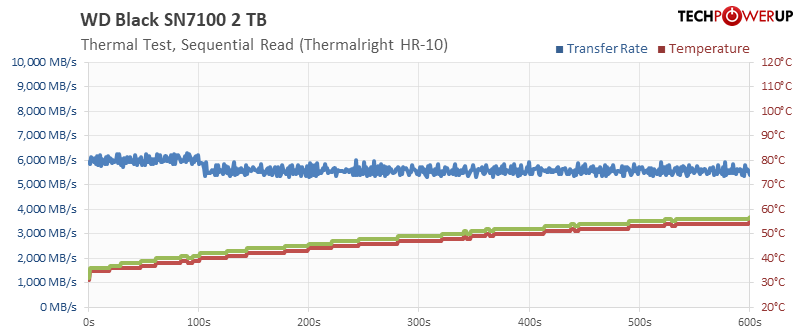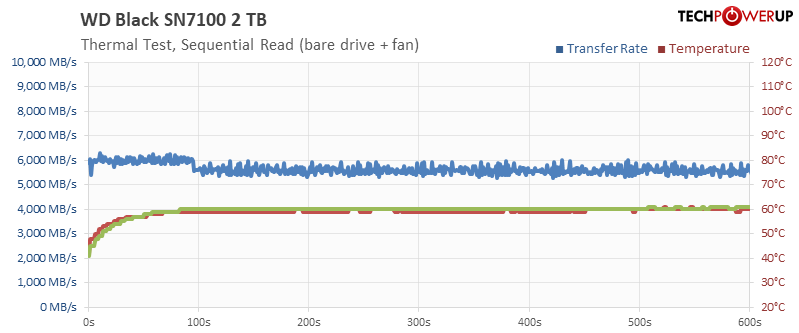 74
74
WD Black SN7100 2 TB Review - The New Best SSD
Windows 11 Startup, Virtualization & File Compression »Thermal Throttling
Due to the compact form factor, M.2 drives lack the ability to actively cool themselves, usually having to rely on passive airflow instead. All vendors include some form of thermal throttling on their drives as a safeguard, which limits throughput once a certain temperature is exceeded.On this page, we will investigate whether the tested drive has such a mechanism, how high temperatures get, and what effect this has on performance. We will test the drive in a typical case, installed in the M.2 slot between the CPU and VGA card, while it's getting hammered by non-stop incoming writes. A first test run, to create a baseline, shows temperature and performance with a 120 mm fan directly blowing on the tested drive. In a second run we report thermal performance of the completely uncooled drive. Each of the charts has time moving from left to right, with the blue line displaying transfer speed in MB/s and the red line showing the temperature in degrees Celsius (measured using SMART).
Results from this test setup are not comparable to our older SSD benches because we're using a different case and an AIO watercooling unit, so there's very little airflow inside the case.
Bare Drive without Heatsink


First, I've tested the drive in the out-of-the-box configuration, without any heatsink or additional airflow. Pretty good results, there's a little bit of thermal throttling in the write test, but only after almost two minutes of non-stop write activity at maximum speed.
Drive with Thermalright Heatsink


Next, I installed a Thermalright TR-M2, which is a compact full-metal heatsink. Throttling is avoided completely now!
Drive with big Thermalright Heatsink


With a much bigger Thermalright HR-10, the temperatures are even better, but there is no additional performance available.
Drive with Fan


Finally, to find out what's possible, and as control, I put a big 80 mm fan in front of the drive with the stock heatsink, to achieve as low as possible temperatures. As expected, no thermal throttling, but also no additional performance vs the numbers with the Thermalright heatsinks.
Thermal Image & Hot Spot

We recorded a thermal image of the running SSD as it was completing the write test. The surface temperature of the drive reached 110°C.
Apr 19th, 2025 02:19 EDT
change timezone
Latest GPU Drivers
New Forum Posts
- I have a dual bay pump reservoir combo question (4)
- (omg)vflash | Fully Patched nvflash from X to Ada Lovelace [v5.780] (365)
- Which 5080 graphics card? (8)
- (Some of) What I'd like to See From a Final Fantasy IX Remake (31)
- HP Zbook 15 G2 GPU Upgrade (1)
- 3090 zotac Trinity Oc dead or psu weak? (41)
- Dangerous RAM temps? (5)
- New PC: Instability and unexpected shutdowns when gaming. (8)
- AsRock 9070 XT Taichi BIOS confusion (3)
- Looking for 4060 MXM-A VBIOS (13)
Popular Reviews
- ASUS GeForce RTX 5060 Ti TUF OC 16 GB Review
- NVIDIA GeForce RTX 5060 Ti PCI-Express x8 Scaling
- Palit GeForce RTX 5060 Ti Infinity 3 16 GB Review
- Teevolution Terra Pro Review
- ASUS GeForce RTX 5060 Ti Prime OC 16 GB Review
- MSI GeForce RTX 5060 Ti Gaming OC 16 GB Review
- Zotac GeForce RTX 5060 Ti AMP 16 GB Review
- MSI GeForce RTX 5060 Ti Gaming Trio OC 16 GB Review
- ASRock X870E Taichi Lite Review
- G.SKILL Trident Z5 NEO RGB DDR5-6000 32 GB CL26 Review - AMD EXPO
Controversial News Posts
- NVIDIA GeForce RTX 5060 Ti 16 GB SKU Likely Launching at $499, According to Supply Chain Leak (182)
- NVIDIA Sends MSRP Numbers to Partners: GeForce RTX 5060 Ti 8 GB at $379, RTX 5060 Ti 16 GB at $429 (127)
- Nintendo Confirms That Switch 2 Joy-Cons Will Not Utilize Hall Effect Stick Technology (105)
- NVIDIA Launches GeForce RTX 5060 Series, Beginning with RTX 5060 Ti This Week (103)
- Over 200,000 Sold Radeon RX 9070 and RX 9070 XT GPUs? AMD Says No Number was Given (100)
- Nintendo Switch 2 Launches June 5 at $449.99 with New Hardware and Games (99)
- Sony Increases the PS5 Pricing in EMEA and ANZ by Around 25 Percent (85)
- NVIDIA PhysX and Flow Made Fully Open-Source (77)